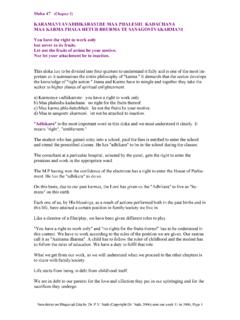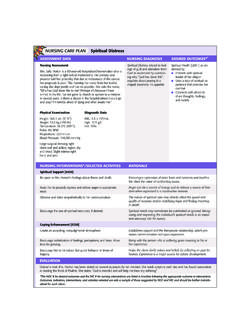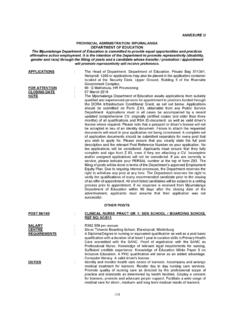Transcription of NA JAYATE MRIYATE VAA KADACHINNAYAM BHOOTVA …
1 Sloka 20 (Chapter 2)NA JAYATE MRIYATE VAA KADACHINNAYAM BHOOTVA bhavita VAA NO BHOOYAHAAJO NITYAHA SASHVATOYAM PURANAM NA HANYATE HANYAMANE SHA REEREIt is not born, nor does it die. After having been, it does not cease to be; unborn, eternal, changeless and ancient. It is not killed when the body is neutral gender "it" is used to refer to "that" which is not the "physical body.""It" refers to the "atman" (soul).Chapter 2, verse 18, Kathopanisad talks of six modifications to the physical body from the time it is born. They are: JAYATE : bornAsti: existsVardhate: growsParinamate: modifies, changesApaksiyate: wearsVinasyati: is this sloka the Lord is using the two words " JAYATE and MRIYATE .
2 " It means "Birth and death."At the time of death, the gross body perishes. The subtle body with the mind, intellect and the atman enters the subtle world of "Moola Prakriti." Parabrahman gives it a new body which goes through all the modifications mentioned above. On death of the gross physical body, again as decided by the Lord, the subtle body enters the "Moola Prakriti" and awaits further births through this process of births and deaths, the atman inside the subtle body is a constant factor. The gross body is the changing factor. We attribute birth and death to the physical body and the term does not apply to the atman.
3 The atman is encased in the subtle body and will continue to be so till the indi vidual finally realises the Lord, drops the attachment to the physical body and the world around. This is the "Salvation" (Moksha).There is therefore no birth or death to the atman. The changes we notice are only applicable to the physical body. This is all in relation to "past, present and future." This body was not present in the past, is present now and will not be there in the future. The physical body is therefore said to be "not eternal."Contrary to it, the atman inside the subtle body was present in the past, is present in the physical body now and will have new body tomorrow.
4 This will stop only when one attains "Salvation." Hence, the atman is comparatively "eternal." When the physical body goes through the changes from babyhood to old age, the atman inside will remain the same and does not Krishna is letting Arjuna know that the warriors getting killed in the war are only the physical bod ies and not the subtle bodies. Newsletter on Bhagavad Gita by Dr. Nath (Copyright Dr. Nath, 2006) sent out week 21 in 2006, Page 1










